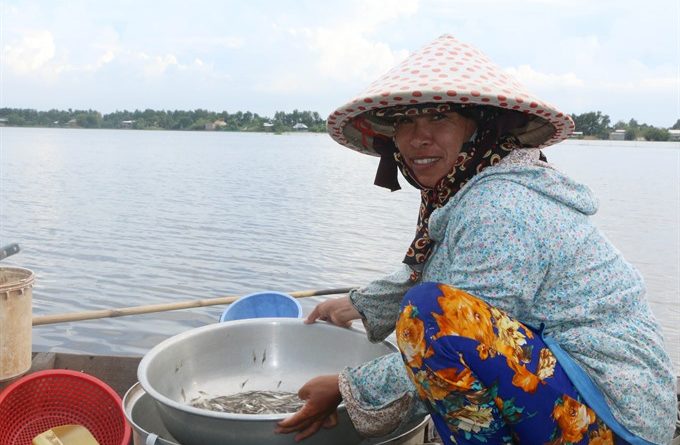Environment: Measures needed to help Mekong Delta farmers cope with floods
Farmer in Long An Province’s Khánh Hưng Commune harvest linh fish during the flooding season. – VNA/VNS Photo Trường Giang
.
HÀ NỘI — More breakthrough solutions are needed to help farmers in the Mekong Delta cope with unpredictably rising water levels, according to experts.
This year, floodwaters caused by heavy rains and water of the Mekong River have been rising at alarming levels, submerging thousands of hectares of rice and crops and causing losses for farmers in Mekong Delta provinces.
The water levels, which are higher than the average over the past decade, are forecast to reach warning Level 2 on the Tiền and Hậu rivers in the next few days.
Since early last month, flooding has struck An Giang, Đồng Tháp and Long An provinces. Local farmers have been relieved as increasing water helps wash away saline residue and brings in aquatic resources.
In the past two years, floods were either low or non-existent, causing severe drought and saline intrusion.
However, early and powerful flooding has caused unpredictable impacts for farmers.
Trương Bảo Đừng, a farmer in An Phú District’s Vĩnh Hậu Commune in An Giang Province, said he set up a net of 20 metres to catch linh fish, a speciality in flood season, but had only caught one or two kilogrammes per day.
“The water is about 1.2 metres higher than the previous year and flowing very fast, sweeping away most of the fish out of the net,” he said.
Nguyễn Văn Cơi, another farmer in the commune, is in the same situation. Cơi said he only caught three or four kilogrammes of tiny fish, earning VNĐ50,000 (US$2.1) per day.
Normally, he could earn up to VNĐ200,000 ($8.6) per day.
Flooding has also affected the crops. Some 8,000 out of 111,000 hectares of rice are located outside the dyke system and at risk of being flooded. In Đồng Tháp Province, at least 150 hectares of crops outside dyke-protected areas have been submerged. Many dykes are likely to be affected by floods, forcing farmers to make an early harvest.
.
– SPACE RESERVE FOR YOUR ADVERTISEMENT –
.
Solutions pose challenges
Over the years, farmers have been encouraged to plant three crops per year instead of four as usual to give the soil a rest. During this time, the water from the floods would enter the closed embankment and bring alluvium, fish and other aquatic resources to the region, improving productivity of crops and fishery resources for farmers.
However, after two years of facing drought due to low flood, many farmers have planted fruit trees instead of letting the soil rest and regain nutrition as the Ministry of Agriculture and Rural Development encouraged.
Phạm Thành Tâm, deputy head of An Phú District’s Agricultural Office, said many farmers whose crops are located in dyke-protected areas have asked authorities to stop discharging water as they had switched to fruit trees.
Lê Văn Nê, farmer in Đa Phước Commune, said floodwaters have not been discharged for years. Nê has spent VNĐ240 million ($10,320) to switch his rice crop into fruit trees on 1.2 hectares of soil since early this year to get more profit.
He has asked local authorities to keep pausing the discharge of floodwaters.
Total cultivated land in the commune is nearly 1,300 hectares. About 220 hectares of rice crops have been switched to fruit trees and subsidiary crops, with the farmers who haven’t losing out.
As a result, the ministry has targeted restructuring agricultural production in the Mekong Delta to be suitable with climate change and floodwaters.
In An Giang, five models of diversified livelihoods, which combine rice crops and shrimp farms and mushrooms and grass for cows, will be implemented in areas outside of dykes in Vĩnh Hậu, Vĩnh Lộc and Phú Hữu communes in An Phú District.
The development of diversified livelihoods for farmers in low-lying areas is an urgent task. This would help ensure the lives of farmers, improve the quality of soil thanks to the floodwaters and ensure rice production in the region, which is considered the country’s rice granary.
More measures needed
According to the ministry’s General Department of Irrigation, five irrigation projects with total capital of more than VNĐ4.7 trillion ($202 million) are needed to help farmers in the Mekong Delta live with floods.
Trần Anh Thư, director of An Giang Province’s Department of Agriculture and Rural Development, said the province was conducting a project to improve the water adaptability and management of the upstream areas in the Mekong River in An Phú District.
It plans to focus on investing in dykes and embankments for floodwater storage.
In addition, policies on supporting and creating faith for farmers to implement the new livelihoods needed priority, experts said. Local authorities in the Mekong Delta should encourage co-operatives to apply the new models.
Local authorities should work with other sectors to attract enterprises to invest in the model from building processing factories to consumption and export to create more profit for farmers, they said. — VNS / Viet Nam News
 All photographs, news, editorials, opinions, information, data, others have been taken from the Internet..aseanews.net | [email protected] / For comments, Email to : Aseanews.Net
All photographs, news, editorials, opinions, information, data, others have been taken from the Internet..aseanews.net | [email protected] / For comments, Email to : Aseanews.Net









